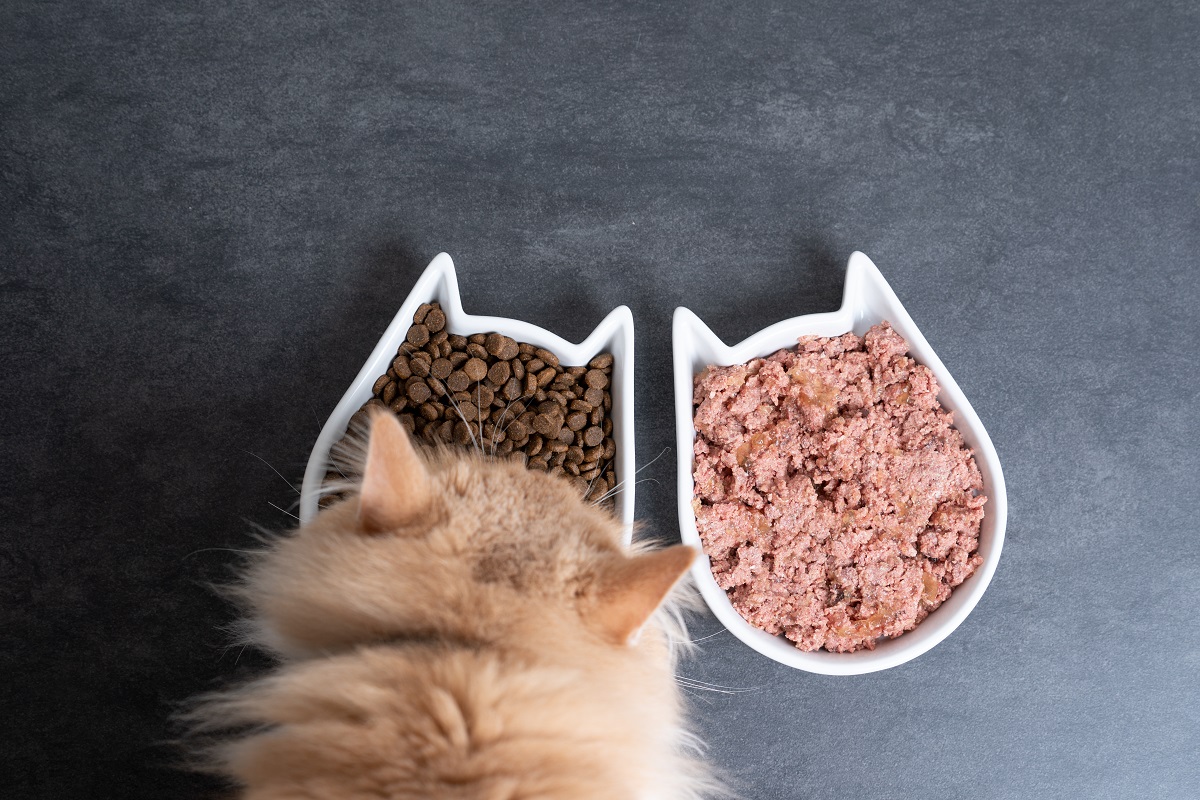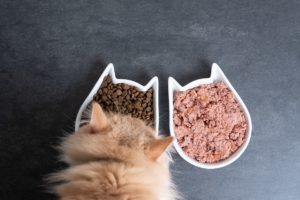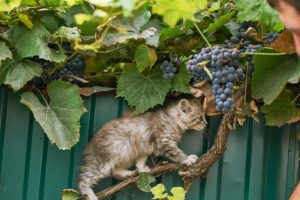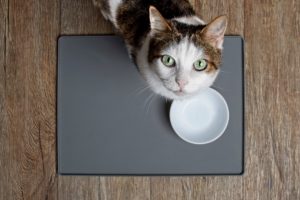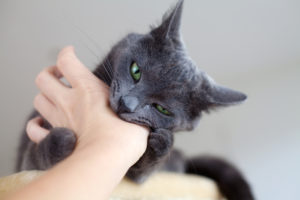For the average cat parent, “should I feed canned or dry cat food?” is a question that provokes anxiety and indecision. Which one is better for your cat’s health? While there are some clear benefits to feeding certain types of diets, veterinarians can help dispel some common myths about whether wet vs. dry cat food is best to incorporate into your cat’s diet.
Myth 1: Dry food improves your cat’s dental health
Some kitty owners think they are doing the best for their cat’s dental health by feeding them dry cat food. “I know Fluffy has great dental health because I feed her only dry food!” is a common sentiment expressed daily at veterinary hospitals around the country.
In fact, there are only a few foods on the market that are proven in independent laboratory studies to reduce the amount of plaque and tartar on your cat’s teeth. What’s the secret? Kibble that retains most of its shape even when the sharp teeth of your favorite feline bite off a piece. While they chew, the larger remaining pieces of kibble act as a kind of toothbrush, rubbing against the surfaces of your cat’s teeth.
These dental diets are not sold over-the-counter and are only available with a veterinarian’s prescription. If you are not feeding your cat one of these special kibbles, then rest assured there is no dental benefit to feeding dry food—the kibble disintegrates into pieces too tiny to have that toothbrush effect once your kitty takes a nibble.
Myth 2: Canned food causes cats to become overweight
Many cat owners believe that canned cat food, also called wet food, is more “rich” in calories and can make their kitty too chubby. Although many cats go crazy for canned food, canned food actually has LESS calories per cup when compared to dry food!
How can this possibly be true? Well, canned cat food consists of up to 80% water —and all of that extra water is both filling AND low in calories. Feeding wet cat food is similar to drinking a glass or two of water with your favorite meal—you’ll end up eating less and consuming fewer calories.
Myth 3: All cats love canned OR dry food
Some cat lovers swear by canned food, saying that all cats prefer it—and some cat lovers say the same about dry food! Which group is right?? The correct answer is: BOTH!
Cats tend to have preferences for the texture of their food—from specific types of canned food (pate, shredded bits in gravy, morsels in gravy) to shapes of dry kibble (round, triangular, square). In some cats, “feel good” hormones are released from the brain’s reward center when they crunch on dry kibble—making it even harder to transition a dry food eater to a wet food eater. These kitties are truly addicted to dry food—and it can be hard to make the switch. For this reason, it’s best to introduce kittens to multiple dry and wet canned food textures so that they don’t develop an aversion to a medically-indicated diet later in life, if needed.
Myth 4: It doesn’t matter what I feed my cat
If it’s difficult to transition a cat from dry food to wet canned food, then why should you consider changing that habit? Does it really matter?
The answer to this particular question is that YES, it definitely matters—to your cat! When we think about how cats evolved to eat, they are normally supposed to hunt, catch, kill and eat small animals for food. Cats are obligate carnivores—their bodies are designed to run on the ultimate high-protein, low-carb diet: birds, mice, lizards, and other small animals. They need essential amino acids that are ONLY found in animal protein in order to survive. (This is why cats cannot survive on a “vegan” diet.)
How does this relate to the canned vs. dry food debate? Well, when we consider their protein and carbohydrate needs, the health of your cat is optimal when fed a high-protein diet—ideally, about 50-60% protein. Carbohydrates are NOT valuable fuel for your cat, and carbohydrate levels lower than 10% are ideal to prevent medical conditions such as obesity and diabetes. When cat food is manufactured into kibble, this process involves dehydrating the ingredients and binding them together to make them keep their form as small pieces—and the ingredients that create these magic shapes are…you guessed it…carbohydrates. Therefore, dry food always has higher than optimal carbohydrate content for our domestic cats.
Another key element that is lacking in dry food for our cats is WATER. You may have noticed that your cat doesn’t drink much water—and there’s a reason for that! Cats evolved in desert conditions, which means that their bodies are very efficient at utilizing water. So efficient, in fact, that their thirst drives are lower than many mammals, and their kidneys (organs that filter waste into the urine) are some of the most sophisticated water-conserving organs of any animal on earth! Unfortunately, kidney disease in older cats is one of the most common chronic medical conditions we see as veterinarians—and it can be truly devastating.
Since cat kidneys are excellent filters, we can help them do their job by promoting more water intake. Increased water creates less work for kitty kidneys, and can help maintain a healthy bladder. Canned food is an excellent way to provide this for your favorite feline. If your cat is addicted to dry food, you can add a teaspoon of water to their kibble at first, and then after a week or two, add two teaspoons of water…and on and on. Eventually, your cat (and their kidneys!) will be happy with canned food—but be patient, as sometimes this cumbersome process can take several weeks up to a few months.
Some cat food puzzle toys will only accommodate dry kibble. Don’t fret—you can feed your kitty a fraction of their daily calories using these hunting toys, and give them the rest with high-quality canned food. You can make up for some of the lost water consumption opportunities by incorporating a cat water fountain into your home. Cats are naturally attracted to running water (as evidenced by any kitty who loves to lap water from a dripping sink, or lick water from the bottom of a freshly-used shower!). You can encourage your cat to drink more just by having one of these bubbly fountains on offer.
As always, no matter what type of food you choose, portion control is essential to maintaining your kitty’s physique and preventing other health problems later in life.
The Bottom Line
As you can see, there are clear health benefits to feeding your cat canned food instead of dry food. However, if you want to incorporate dry food into your kitty’s feeding routine, you can still provide health benefits to your beloved cat by adding some water to their kibble at each meal and incorporating a water fountain into your home!
Our AskVet Veterinarians are available to discuss all of your pet’s needs 24 hours a day, 7 days a week. Whether it’s learning how often you should feed a cat, understanding the different toxic foods for cats, or how to get a cat to lose weight, just sign into your account, and one of our friendly and knowledgeable veterinary experts will attend to your needs, no appointment required!
Written by:
Allison Ward, DVM
Dr. Allison Ward grew up in the suburbs of Washington, D.C. and started working in veterinary hospitals when she was 14 years old. After graduating from veterinary school in 2011, she completed a small animal rotating internship in New Jersey, followed by a neurology/neurosurgery internship in Miami. After completing this advanced training, Dr. Ward then moved on to general small animal practice. Dr. Ward’s professional interests include feline medicine, neurology, and pain management. Her passion for educating pet owners carries over into her work with AskVet, and she loves being able to help pets and their parents at all times of the day (and night!). She currently resides in sunny south Florida with her two cats, Larry and George.

